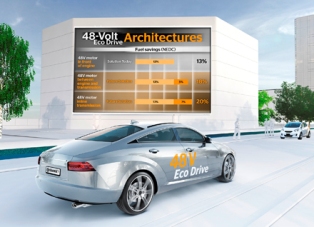Automotive supplier Continental announced that it has started the development of solutions for future 48 V hybrid architectures, which will hit production in 2016.

The company said that the integration of a second voltage level of 48 V into the vehicle would enable significant reduction in CO2 emissions.
Continental claims that the 48 V architecture integrates the starter generator into the engine's belt drive (Belt Starter Generator, BSG), and has resulted in fuel savings of 13% in the New European Driving Cycle (NEDC).
The company also claims that vehicles can save up to 20% through Hybrid driving strategies.
The 48V system facilitates fuel efficiency because it synchronizes the engine with the driveline at any given speed, which allows shutting down and restarting the engine whenever possible.
The company claims that the 48V architecture improves the restart function of the vehicle while it can also provide power for pre-heated electric catalysts that is necessary to manage emissions in stop-start engines.
The 48 V system has higher voltage level which can provide the necessary energy for the components to work more efficiently.
Continental has collaborated with Schaeffler to develop a prototype module named P2-BSG with 48 V BSG and integrated belt drive, which is expected to be ready for volume production starting in 2020.
By adding a second coupling in front of the module, the BSG will be driven by the belt, without the use of internal combustion engine, which will result in fuel savings, and production of more energy.
Continental is working on a third integration level with the starter generator, which is fully integrated between engine and transmission (Inline Starter Generator, ISG), which is expected to further improve fuel savings.
Continental Powertrain Division head José Avila said: "In the future, the demands on 48 V technology will increase even more.
"The aim will be to achieve even greater efficiency benefits with less installation space and weight while keeping costs the same.
"The integration architecture of a 48 V system can make a big contribution here. That is why we are developing other 48 V architecture solutions for the period after 2020."
Image: Continental introduces new solutions for future 48 Volt Hybrid Architectures. Photo: Continental AG 2015.





